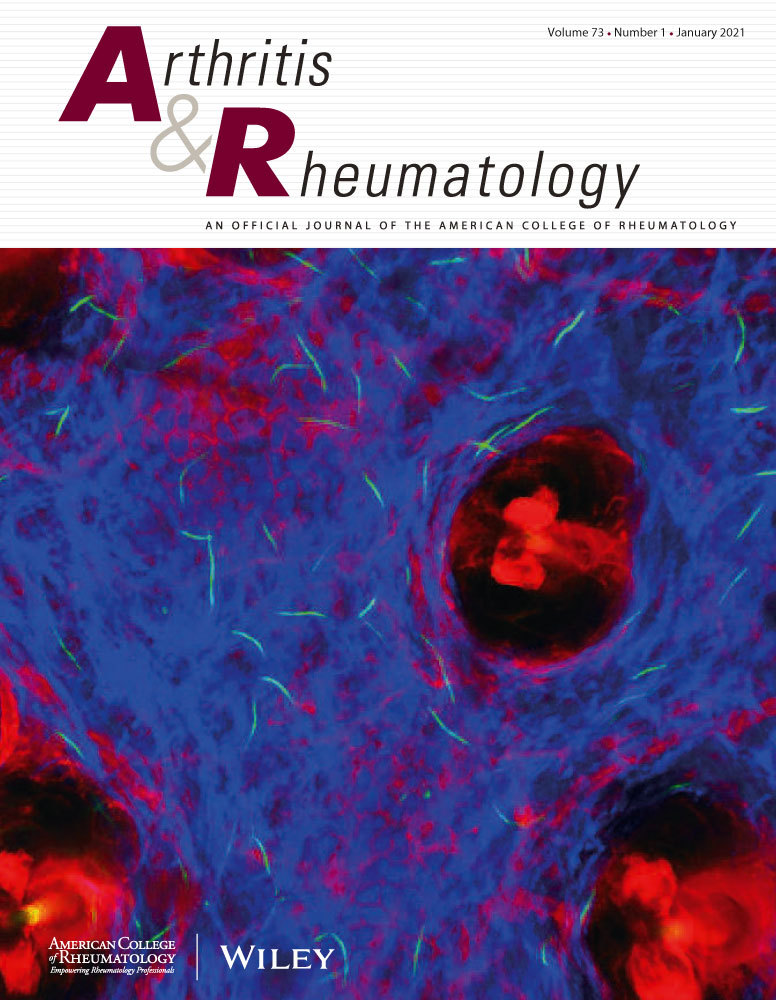FGL-1 Modulates Inter-Organ Communication by Controlling T Cell Homeostasis during the Onset of Sjögren's Disease.
IF 10.9
1区 医学
Q1 RHEUMATOLOGY
引用次数: 0
Abstract
OBJECTIVE Autoimmunity occurs due to the tactics between pathogenic and regulatory factors in systemic organs. Although inter-organ communication has been demonstrated in various diseases, the effects of the crosstalk between the immune system and other organs on autoimmune disease is unknown. METHODS We analyzed the influence of inter-organ communication on the cellular or molecular mechanism of autoimmunity using a mouse model of primary Sjögren's disease (pSjD) and patients with pSjD by integrative genomic, bioinformatics, pathological, and immunological analyses. RESULTS Fibrinogen-like protein-1 (FGL-1) was identified as a potent factor for inter-organ communication between the liver and immune system in pSjD model mice. The production of FGL-1 of the liver is induced by IL-6 from CD4+ T cells in these mice. The onset of autoimmune lesions in Fgl1-deficient pSjD model mice was earlier than that in the WT-pSjD model mice. FGL-1 produced in the liver regulates naïve/memory T cell homeostasis. Further, FGL-1 was significantly upregulated in patients with pSjD compared to the controls. Moreover, its concentration was closely related to the serum IL-6 levels in patients with pSjD. CONCLUSION FGL-1 plays a key role in the onset of autoimmunity by suppressing T cell activation in pSjD. Our results will facilitate the development of novel diagnostic or therapeutic strategies targeting the inter-organ communication for autoimmune diseases.FGL-1在Sjögren病发病期间通过控制T细胞稳态调节器官间通讯。
目的自身免疫的发生是由于全身器官的致病因子与调节因子相互作用的结果。虽然器官间通讯已在多种疾病中得到证实,但免疫系统与其他器官之间的串扰在自身免疫性疾病中的作用尚不清楚。方法采用基因组学、生物信息学、病理学和免疫学等综合分析方法,分析了器官间通讯对小鼠原发性Sjögren病(pSjD)和pSjD患者自身免疫的细胞或分子机制的影响。结果纤维蛋白原样蛋白-1 (FGL-1)是pSjD模型小鼠肝脏与免疫系统间通讯的重要因子。在这些小鼠中,来自CD4+ T细胞的IL-6诱导肝脏中FGL-1的产生。fgl1缺陷型pSjD模型小鼠的自身免疫性病变发病时间早于WT-pSjD模型小鼠。肝脏中产生的FGL-1调节naïve/记忆T细胞稳态。此外,与对照组相比,pSjD患者的FGL-1显著上调。其浓度与pSjD患者血清IL-6水平密切相关。结论fgl -1通过抑制pSjD的T细胞活化,在自身免疫的发生中起关键作用。我们的研究结果将促进针对自身免疫性疾病的器官间通讯的新诊断或治疗策略的发展。
本文章由计算机程序翻译,如有差异,请以英文原文为准。
求助全文
约1分钟内获得全文
求助全文
来源期刊

Arthritis & Rheumatology
RHEUMATOLOGY-
CiteScore
20.90
自引率
3.00%
发文量
371
期刊介绍:
Arthritis & Rheumatology is the official journal of the American College of Rheumatology and focuses on the natural history, pathophysiology, treatment, and outcome of rheumatic diseases. It is a peer-reviewed publication that aims to provide the highest quality basic and clinical research in this field. The journal covers a wide range of investigative areas and also includes review articles, editorials, and educational material for researchers and clinicians. Being recognized as a leading research journal in rheumatology, Arthritis & Rheumatology serves the global community of rheumatology investigators and clinicians.
 求助内容:
求助内容: 应助结果提醒方式:
应助结果提醒方式:


